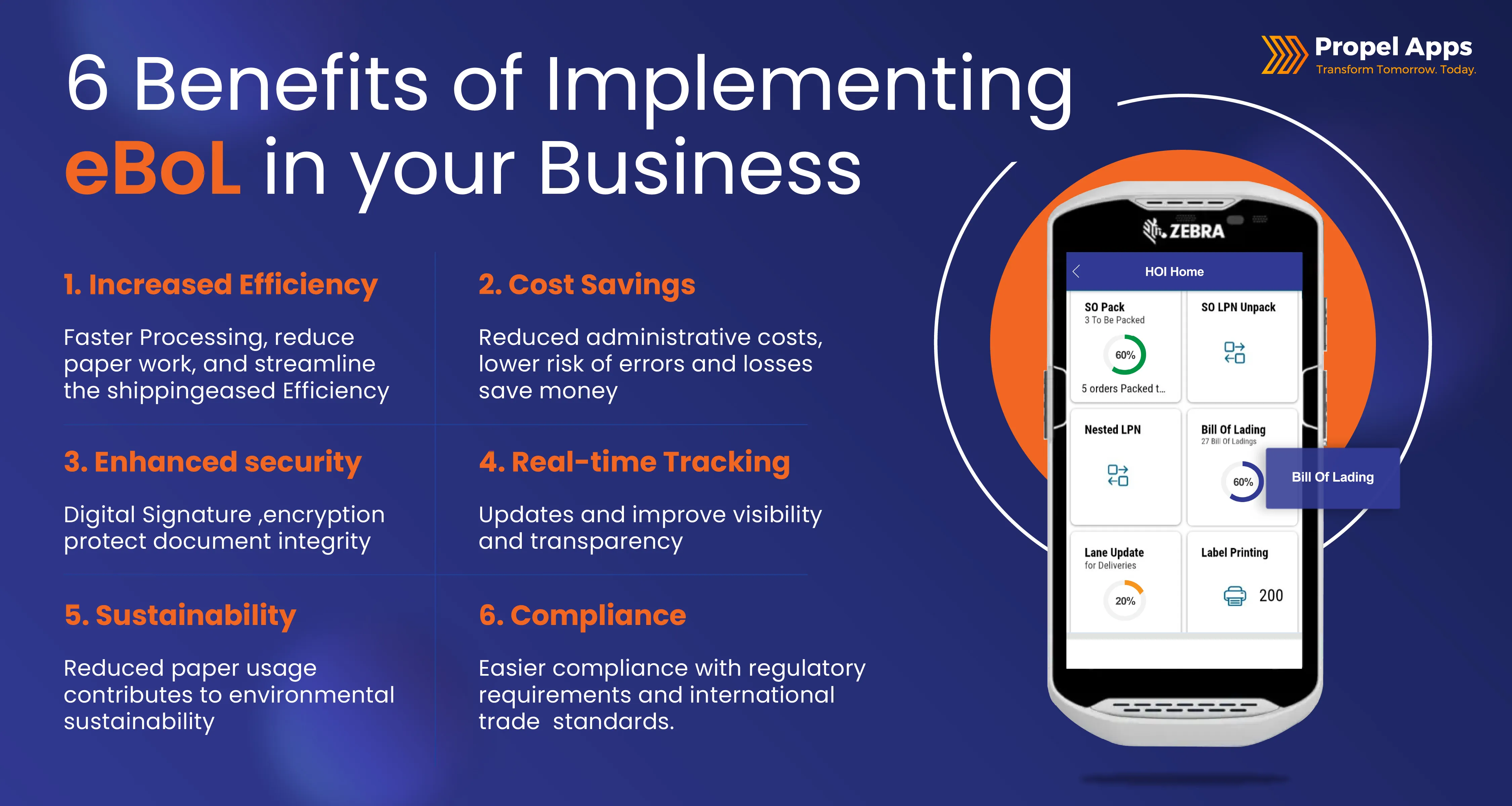
International trade is growing, so is the requirement for foolproof documentation that meets the requirements of all parties involved, while complying with the legal procedures. Here, fool-proof documentation refers to bill of lading - a legal document issued by a carrier to a shipper, acknowledging receipt of goods for transport. It serves as a receipt, evidence of the contract of carriage, and document of title, allowing the holder to claim the cargo. In other words, a bill of lading is crucial in international trade, providing a document trail for the goods being shipped and ensuring that all parties involved in the shipping process have a clear understanding of the terms of transport.

However as businesses strive to streamline their operations and reduce costs, traditional paper-based processes are being replaced by digital solutions. One such transformative change is the adoption of the Electronic Bill of Lading (eBoL). This digital document is set to revolutionize the shipping industry, offering numerous benefits of Electronic Bill of Lading over its paper-based counterpart.
In this blog, we will explore the differences between paper-based and eBoL, how eBoL works, its legal and regulatory framework, steps to implement it in your business, its benefits, and how a mobile eBoL solution can help in improving the efficiency of your logistics operations.
While both paper-based and eBoL serve the same essential functions, they differ significantly in their execution and benefits. This section talks about the essential differences between both types of formats, its objectives and benefits of Electronic Bill of Lading.
| Parameter | Paper based Bill of Lading | Electronic Bill of Lading |
| Format | Physical Document: Issued in physical form and requires physical handling and storage. Multiple Copies: Often produced in multiple copies (original and duplicates) that need to be physically signed and stamped. | Digital Document: Issued, transferred, and stored in electronic form. Single Copy: Maintained as a single authoritative copy that can be easily updated and accessed by authorized parties. |
| Processing Time | Longer Processing: Physical transfer and handling can lead to delays, especially if sent via courier services across different locations. | Faster Processing: Instantaneous transfer and access, reducing delays associated with physical handling. |
| Security | Risk of Loss or Damage: Susceptible to physical damage, loss, or theft. Forgery: Higher risk of forgery and tampering. | Enhanced Security: Digital signatures, encryption, and secure transmission reduce the risk of loss, theft, or forgery. Audit Trail: Provides an auditable trail of all transactions and changes. |
| Storage & Archiving | Physical Storage: Requires physical space for storage and archiving, leading to higher costs and potential difficulties in retrieval. | Digital Storage: Requires digital storage, which can be more efficient and cost-effective, with easier retrieval and management. |
| Legal Acceptance | Widely Accepted: Long-established and widely recognized in international trade, with established legal frameworks supporting it. | Increasing Acceptance: Gaining acceptance with the development of international standards and legal frameworks like the UNCITRAL Model Law on Electronic Transferable Records (MLETR). |
| Cost | Higher Costs: Involves costs for printing, handling, courier services, and physical storage. | Lower Costs: Reduces costs associated with printing, handling, courier services, and physical storage |
The transition from paper to eBoL involves several key steps and technologies. Here’s a breakdown of how eBoL works:
The eBoL is created and issued by the shipper or a third-party platform using digital tools. This includes all the necessary details such as the description of goods, shipment terms, and consignee information.
All parties involved (shipper, carrier, consignee) can digitally sign the document using secure digital signatures, ensuring authenticity and integrity.
The eBoL is transmitted electronically through a secure platform or system, accessible to all authorized parties.
The status of the shipment can be tracked in real-time, and any updates or changes can be immediately reflected in the document.
The electronic document is stored securely in a digital repository, making it easily retrievable for future reference or compliance purposes.
The legal and regulatory framework surrounding eBoL is crucial for its widespread adoption and effectiveness. Several international conventions and regulations govern the use of eBoL.
The United Nations Commission on International Trade Law (UNCITRAL) has developed a model law that provides a legal framework for electronic commerce, including eBoL.
The International Chamber of Commerce (ICC) has developed the Uniform Customs and Practice for Documentary Credits (eUCP) and Uniform Rules for Collections (eURC), which include provisions for electronic documents.
Many countries have their own regulations and laws that recognize and govern the use of electronic Bills of Lading. These laws often align with international standards to facilitate cross-border trade.
Various international trade agreements and partnerships also include provisions for the acceptance and use of electronic documentation, including eBoL.
Implementing eBoL in your business involves several steps to ensure a smooth transition and integration with your existing systems:
Evaluate your current processes and technology infrastructure to determine readiness for eBoL implementation.
Select a reliable eBoL platform or service provider that meets your business needs and complies with legal and regulatory requirements.
Train your staff and stakeholders on the use of the eBoL platform and the benefits of Electronic Bill of Lading.
Integrate the eBoL platform with your existing supply chain management and enterprise resource planning (ERP) systems for seamless operation.
Start with a pilot program to test the implementation process and resolve any issues before full-scale deployment.
Continuously monitor the performance of the eBoL system and make necessary adjustments to optimize efficiency and effectiveness.
The adoption of eBoL offers numerous benefits to businesses and the shipping industry as a whole. The benefits of Electronic Bill of Lading include:

Faster processing and reduced paperwork streamline the entire shipping process.
Reduced administrative costs and lower risk of errors and losses save money.
Digital signatures and encryption protect the integrity and authenticity of the document.
Real-time updates and tracking improve visibility and transparency in the supply chain.
Reduced paper usage contributes to environmental sustainability.
Easier compliance with regulatory requirements and international trade standards.
Now that we have understood the key benefits of eBoL, let's now move on to the next section to understand and appreciate the role of an eBoL tool in optimizing the efficiency of the shipping operations.
An eBoL tool revolutionizes traditional shipping documentation by digitizing the process of creating, managing, and transferring bills of lading, which are essential in global logistics. Unlike conventional paper-based systems, eBoL tools leverage digital technologies to streamline operations, enhance data accuracy, and improve overall efficiency in supply chain management.
By eliminating the need for physical paperwork, these tools enable real-time access to shipping documents, facilitate faster transactions, and reduce administrative costs. They also ensure greater security through encryption and digital signatures, mitigating risks associated with fraud and document tampering. In essence, eBoL tools represent a pivotal shift towards a more agile, transparent, and sustainable logistics industry, empowering businesses to adapt to the demands of modern commerce effectively.

An eBoL tool eliminates the need for physical paperwork by digitizing the entire bill of lading process. This includes creating, editing, and storing electronic documents securely in the cloud. Digital documentation reduces errors associated with manual data entry and ensures that shipping information is easily accessible and searchable.
One of the standout features of an eBoL tool is its ability to provide real-time updates. Shippers, carriers, and consignees can track the status of shipments instantly, ensuring transparency throughout the supply chain. This feature enhances communication and enables stakeholders to make informed decisions promptly.
A good eBoL tool can seamlessly integrate with other logistics management systems such as transportation management software (TMS) and enterprise resource planning (ERP) systems. This integration facilitates data exchange across platforms, automates tasks like invoicing and inventory management, and enhances overall operational efficiency.
An eBoL tool enables electronic signatures, which streamlines the approval process significantly. This feature allows parties involved in the shipment — including drivers, warehouse managers, and recipients — to sign documents digitally, reducing delays and paperwork.
Built-in compliance checks ensure that an eBoL tool adheres to regulatory requirements across different jurisdictions. Additionally, robust security measures protect sensitive shipping data from unauthorized access, ensuring confidentiality and integrity.
A modern eBoL tool can be easily accessible via web browsers and mobile applications, enabling stakeholders to manage shipments from anywhere at any time. This flexibility supports remote work and enhances collaboration among dispersed teams.
An advanced eBoL tool offer analytics capabilities that provide insights into shipping trends, performance metrics, and cost analysis. These reports help logistics managers optimize routes, reduce transportation costs, and improve overall supply chain efficiency.
Having discussed the key benefits of Electronic Bill of Lading over a conventional paper-based system, the next step is to explore and invest in the right eBoL tool that works for your organization in optimizing your logistics operations. While there are a couple of solutions in the market that boast good features, some of them may not perfectly meet your business requirements. Added to that is the huge costs involved in buying such a solution. Hence, you need to invest in a solution that strikes a perfect balance - the right features that your warehouse operations require and a cost that is affordable.
In the above context, explore Propel Apps' eBoL solution that offers the right features for your supply chain and logistics operations, while being cost-effective. By using Propel Apps' eBoL tool, you can eliminate all manual and time-consuming processes associated with generating, storing, archiving, and retrieving BoL documents.
Here are some key benefits your organization can gain from using Propel Apps' eBoL tool:
To learn more about this solution and its key features, schedule a call with us today for a free demo.
The shift from paper-based to electronic Bills of Lading represents a significant advancement in the shipping and logistics industry. The eBoL offers numerous advantages, including increased efficiency, cost savings, enhanced security, and real-time tracking.
As legal and regulatory frameworks continue to evolve, and as businesses increasingly recognize the benefits of Electronic Bill of Lading, the adoption of eBoL is set to become the standard. Implementing eBoL in your business can provide a competitive edge, streamline operations, and contribute to a more sustainable and efficient supply chain. Embrace the digital transformation and take advantage of the opportunities offered by eBoL to stay ahead in the fast-paced world of international trade.